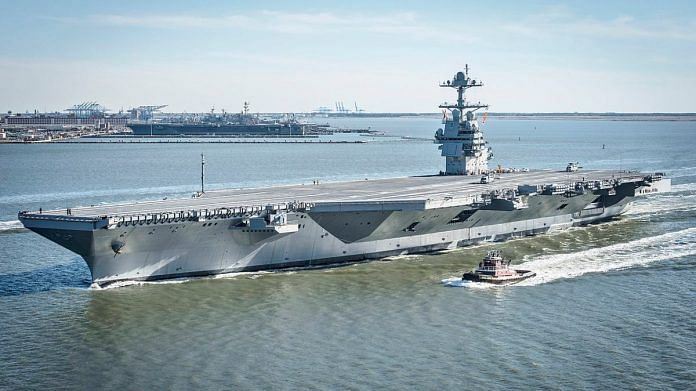Washington: Three combat systems on the $13 billion USS Gerald R. Ford have been found deficient in recent tests, raising questions about whether the aircraft carrier will be able to defend itself, according to the Pentagon’s testing office.
Navy evaluations of defensive capabilities for the costliest U.S. warship revealed “deficiencies and limitations” with its radar, electronic warfare surveillance system and a ship-to-ship communications data network, said in an annual Pentagon report released Thursday.
“These deficiencies and limitations reduce the overall self-defense capability of the ship,” Robert Behler, the Defense Department’s director of testing, said in the report, which offers an assessment of major weapons systems including the carrier and the F-35 fighter jet.
Defensive capabilities of aircraft carriers are always a concern because they are such large and relatively slow-moving targets. Behler said the Navy hasn’t budgeted funds to conduct three of four additional tests planned using a specialized “self-defense” testing vessel.
“If the Navy does not conduct all of the remaining events, testing will not be adequate to assess the operational effectiveness of the CVN-78 combat system,” Behler wrote, using the Ford’s official designation.
In particular, the electronic warfare surveillance system built by Lockheed Martin Corp. “demonstrated poor performance that prompted the Navy to delay additional operational tests until those problems were corrected,” the test office said.
William Couch, a spokesman for the Naval Sea Systems Command, said in an email that the Ford’s crew “continues to operate and to test an aircraft carrier that has dramatic advances in propulsion, power generation, ordnance handling and aircraft launch systems that will bring significant efficiencies and cost savings” over previous Nimitz-class carriers.
The previously undisclosed flaws add to established problems with the carrier built by Huntington Ingalls Industries Inc. including with the installation and certification of elevators needed to lift munitions from below deck. As of November, four of the 11 “advanced weapons elevators” that should have been installed when the ship was delivered in May 2017 are now operational.
Acting Navy Secretary Thomas Modly, who’s made fixing the Ford one of his priorities, said Wednesday that he expected seven of the elevators to be turned over to the Navy by December. The elevator situation has been “sort of a disaster up until now, to be frank, but we are getting after that problem,” he said at a conference in Washington.
The carrier got under way in November and is beginning 18 months of verification tests at sea, which the Navy says will get the crew familiar with new equipment and certified. The test office said the vessel may finally deploy on patrols in fiscal 2023.
Bunk Space
By then, the Navy may have to address a problem far less technologically complex than an inadequate radar system or balky munitions elevators: Not enough bunks for the crew.
The Ford “will likely be short of berthing spaces” once the Navy fully evaluates personnel requirements for the ship’s crew as well as the air wing and temporary detachments on board, Behler wrote.
The vessel has berthing capacity for 4,660 sailors, or 1,000 fewer than the older Nimitz-class carriers. But “recent estimates of expected combined manning” go as high as 4,758, according to the test office report.
Couch, the spokesman for the Naval Sea Systems Command, said “the ship’s bunks will be sufficient” to meet requirements for the carrier’s first deployment.-Bloomberg
Also read: Russia getting close to China one joint military exercise at a time. India must worry






